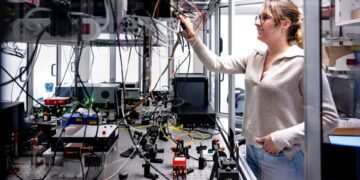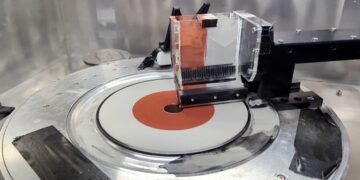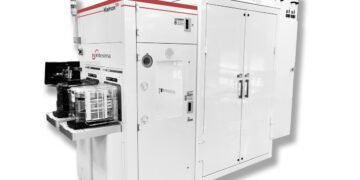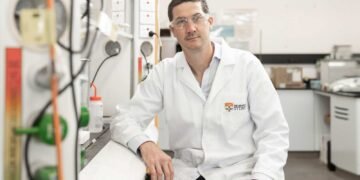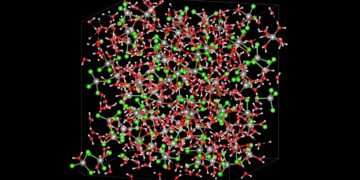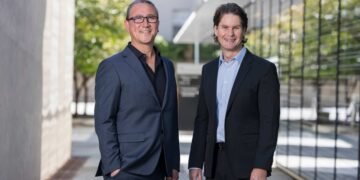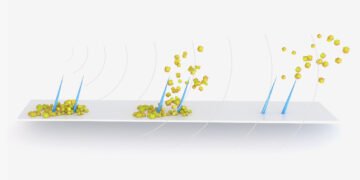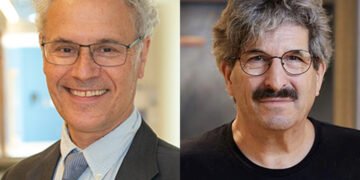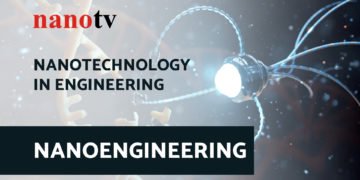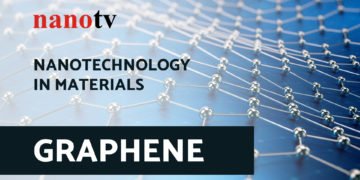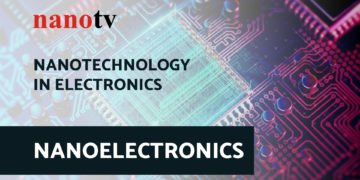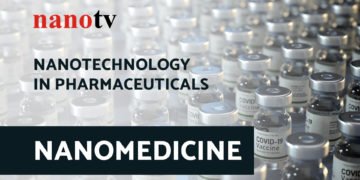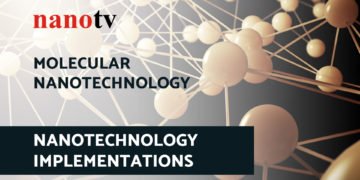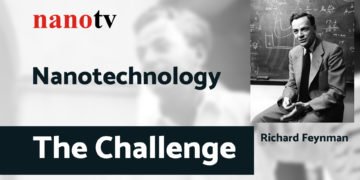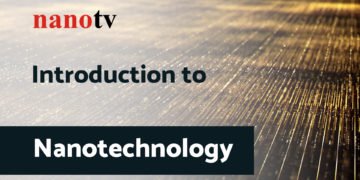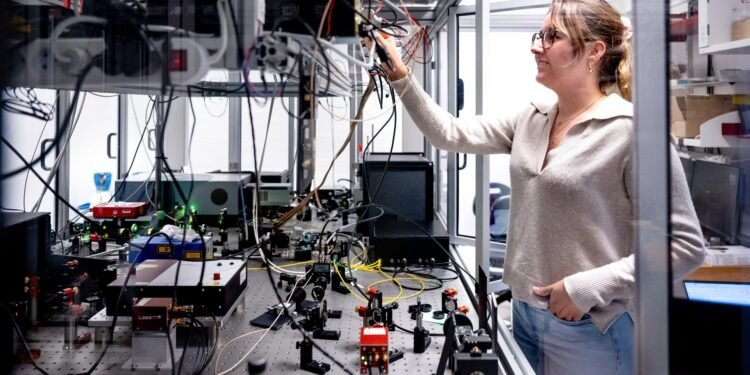Quantum technology is becoming more ubiquitous. There is a lot of potential, especially in the sensor area. Quantum physics is not new, but only recently have we been able to manipulate quantum phenomena and use them to create new technologies, Quantum sensors can offer all new possibilities. One of the areas where quantum technology is most mature and ready for application is in quantum sensors, where quantum effects can help make sensors more sensitive, allowing them to see details and measure quantities.
Diamonds are not good as quantum sensors
Alexander Huck is one of the DTU researchers who has been researching the use of diamond as a quantum sensor for more than ten years. They are synthetic diamonds with an internal defect: center NV. The NV center (A NV diamond quantum sensor is based on an artificial diamond. A defect in the structure of the diamond is exploited by replacing a carbon atom with a nitrogen atom and leaving the neighbouring space vacant behaves like a spinning machine that can register a weak magnetic field with other physical components.
Alexander Huck used quantum diamonds to measure living things, among other applications. In 2020, he demonstrated, together with a multidisciplinary research team, that it is possible to measure electrical activity in nerves using NV diamond quantum sensors (A NV diamond quantum sensor is based on an artificial diamond. A defect in the structure of the diamond is exploited by replacing a carbon atom with a nitrogen atom and leaving the neighbouring space vacant (NV= Nitrogen vacancy). This impurity causes the diamond to behave like an atom with the quantum state spin. This means that it can be affected by weak magnetic fields. Measuring the light emitted by diamonds makes it possible to map activities in the material being measured).
“The advantage of using diamonds to measure living things is that we don’t need to put electrodes on the thing to measure the signal. Instead, we can place the diamond, in this case in the form of a small flat plate measuring 1-2mm x 1-2mm, close to living things without “damaging” it, and measure the signal from using a magnetic field. “Recently, we managed to make a similar brain function from tissue in mice, which is a big new step,” says Alexander Huck, associate professor at DTU Physics. In his opinion, quantum sensors will play an important role in the work to gain more knowledge about the brain and neural networks, which can contribute to both better diagnosis and treatment of brain disorders.
Knowledge of molecules and photosynthesis
Alexander Huck has recently begun to use diamond NV sensors at longer wavelengths than nerves and brain tissue. He wanted to try using quantum sensors to deepen his knowledge of particles. The focus is on electronic processes at the molecular level, such as photosynthesis, which he wants to understand by examining one or a few cells at a time. “If we can fully understand how photosynthesis works, it may, in the long run, allow us to model how plants capture energy from the sun and convert it into This chemical is stored and transferred. Most of our current knowledge is based on the analysis of large groups of molecules, which can cover some details. I want to gain knowledge about them by examining the cells individually,” explains Alexander Huck.
More information on human cells
Kirstine Berg-Sørensen also uses quantum technology for biological sensors, but with small diamonds. Its purpose is to gain a better knowledge of our cells.
“In recent years, cell biology researchers have discovered that cells are not as diverse as previously thought. Each cell grows in a different way, even though they start from the same place. This applies, for example, to cancer cells, but also to immune cells, which is my area of expertise. It is important to gain a deeper understanding of the cells responsible for disease development and individual disease control,” says Kirstine Berg-Sørensen, associate professor at DTU Health Tech.
Kirstine Berg-Sørensen has worked in the lab with optical traps ( An optical trap is the use of highly focused laser light to capture the object under examination) throughout her career. In this work, highly focused infrared light is used to examine living things. In this way, the fire does not destroy the property and therefore does not make changes related to analysis. “About six years ago, thanks to the work of Alexander Huck, I became aware of nanodiamonds, which make it possible to record weak magnetic fields, for example in human tissue. This gave me the idea to study cells by combining our methods, and we are now working on this,” says Kerstine Berg-Sørensen.
Combine the two
The cells first penetrate tiny nanodiamonds that have a diameter of about 120 nanometers, or 500 times smaller than the thickness of a human hair. Researchers use laser light to read what a diamond weighs.
Ultimately, the goal is to develop a high-quality repair kit for living things based on these two methods. The advantage of diamonds and optical traps is that they are compatible, which means that they do not interact with living things and therefore, do not “disrupt” anything related to size. In addition, their magnetic ability can work at room temperature, so it does not require a temperature below minus 150 degrees, unlike other types of quantum effects.
“We have already shown that we can get cells to get nanodiamonds. Now we need to improve our system to get optical tweezers, laser light, to “push” the diamond into the cell, so that we can check many parts of the cell. We are currently working on it,” said Kirstine Berg-Sørensen.
Development of new quantum sensors
Although quantum sensors are already able to make measurements better than ordinary sensors, work is being done to improve them further, for example through collaboration between researchers working on the development of new materials, and while Alexander Huck contributes his expertise in NV and quantum diamond sensor.
“Our goal is to investigate whether we can find a new sensor that is small, portable, that can work at room temperature and can measure the magnetic field in the brain of living things. . This will help us to expand our knowledge about the system in the brain. We are planning to create a new sensor using new bespoke 2D materials that will help us control defects at the atomic level,” explains Nini Pryds, professor at DTU Energy, scientist and project leader. The goal of this specific project is to create a completely new quantum sensor based on 2D materials that will be more sensitive than diamond.
“In order to create better, cheaper and more effective small sensors, we will investigate whether it is possible to use different types of magnetic sensors based on 2D materials. With the new sensor, our future goal is to be able to provide a better diagnosis at an early stage, before the brain disease has time to develop further,” says Nini Pryds.
The development of the new sensor will also benefit from a new research facility at DTU, E-MAT. It is the first of its kind in Northern Europe, for the integration of the new generation of quantum material and it is only available in a few places in the world. E-MAT has a glove box with a controlled environment that includes several key components, including a state-of-the-art investment system that allows surface and face control at the atomic level. This software will not only make it possible to predict new things, but also to create these things and test them. This makes the researchers confident that they will be successful in developing new quantum sensors in the coming years.
Quantum Sensor Experiments
Some quantum sensors are already in such a state of development that their use is being tested in real-world situations. This includes a fast tracking device, which can replace the GPS system for navigation in the future. In the current test form, the quantum sensor is a large box that takes up a lot of space when it is installed on a plane and sent to Greenland to pass through the Earth’s gravitational field. One of the goals will be to reduce the quantum sensor and the size of the chip so that in the future it will be used anywhere, in airplanes, ships, buildings, underground and under heaven “water. This will guarantee the independence of the GPS system, which can be damaged or destroyed, which poses a threat to the current geopolitical situation.
Source: Technical University of Denmark
